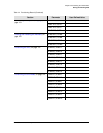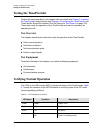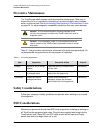
097-58001-02 Revision G – April 2008 TimeProvider User’s Guide 151
Chapter 5 Testing the TimeProvider
Testing the Communication Ports
Detecting Input Errors
You can provision the TimeProvider to perform a variety of functions when an input
error occurs. Possible errors include:
AIS - Alarm Indication Signal
LOS - Loss of Signal
OOF - Out of Frame
Loss of Alignment
Excessive wander
Input is disqualified
GPS faults
The TimeProvider reports these and other errors on the front panel alarm LEDs, in
an autonomous event message, and via devices connected to the alarm relays. You
can provision each error to a specific alarm level (Minor, Major, or Critical).
Setting an Alarm Strategy
You can set up the input alarms to prevent spurious input errors from triggering an
alarm. The FLTDELAY keyword parameter sets a period from 1 to 15 seconds that
an input error must be present before the alarm is issued. You can provision the
alarm to clear from 1 to 1000 seconds after the input error clears using the
CLRDELAY keyword parameter. Use the ED-SYNC command syntax described in
Provisioning System-Level Alarms, on page 130 to provision the FLTDELAY and
CLRDELAY keywords.
Testing the Communication Ports
The TimeProvider has three communication ports. This section describes how to test
each port; if you do not plan to use a port, then you can skip the corresponding test.
Local Craft serial port
Remote serial port
Ethernet port
Testing the Local Craft Serial Port
The local Craft serial port is on the faceplate of the IMC or IMC/TPIU, and is
configured as a DCE device. The default settings for the local Craft serial port are
9600 Baud, 8 bits, no parity, 1 stop bit, echo on, and handshaking disabled.
To connect a device to the local Craft port, perform the following steps:


















